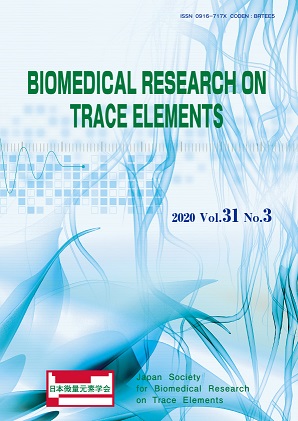All issues

Volume 31 (2020)
- Issue 3 Pages 92-
- Issue 1 Pages 1-
Volume 31, Issue 3
2020 Vol.31 No.3
Displaying 1-3 of 3 articles from this issue
- |<
- <
- 1
- >
- >|
Review Article
-
Haruna Tamano, Atsushi TakedaArticle type: Award Review Article
2021Volume 31Issue 3 Pages 92-97
Published: March 09, 2021
Released on J-STAGE: March 09, 2021
JOURNAL FREE ACCESSZinc is essential for the growth and function of the brain and dietary zinc deficiency causes abnormal behavior. A part of zinc in the brain functions as zinc ion (Zn2+). Zn2+ concentrations in the intracellular and extracellular fluid in the hippocampus are estimated to be ~100 pM and ~10 nM, respectively. Extracellular Zn2+ dynamics in the hippocampus is involved in both cognitive activity and its decline, and dynamically influenced by extracellular glutamate concentration and amyloid β1-42, a causative peptide of Alzheimer’s disease. Extracellular Zn2+ concentration in the hippocampus is increased along with aging. The age-related increase in extracellular Zn2+ leads to intracellular Zn2+ dysregulation in the neuron, followed by cognitive decline and neurodegeneration. Therefore, intracellular Zn2+ dysregulation is a risk factor of age-related neurodegenerative disorders. On the other hand, metallothionein, an intracellular Zn2+-binding protein, plays a key role for intracellular Zn2+ homeostasis and is also closely linked to hippocampal function. On the basis of our studies, here we review Zn2+ function and its toxicity in the hippocampus.View full abstractDownload PDF (804K) -
Vladimir ZaichickArticle type: Review Article
2021Volume 31Issue 3 Pages 98-116
Published: March 09, 2021
Released on J-STAGE: March 16, 2021
JOURNAL FREE ACCESSBackground: In many studies it was found that the Zn level in prostatic tissue plays an important role in etiology benign prostate hypertrophy (BPH) and its measurement may be useful as a biomarker for differential diagnosis of hyperplastic and malignant transformations of gland. These findings promoted more detailed studies of the Zn content in the prostatic tissue of subjects with BPH.
Method: The present study evaluated by systematic analysis the published data for Zn content analyzed in hyperplastic prostates as well as in normal glands. This evaluation reviewed 1885 studies, all of which were published in the years from 1921 to 2019 and were located by searching the databases Scopus, PubMed, MEDLINE, ELSEVIER-EMBASE, Cochrane Library, and the Web of Science. The articles were analyzed and “Median of Means” and “Range of Means” were used to examine heterogeneity of the measured Zn content in prostates of men with BPH and in prostates of apparently healthy adult subjects (control group). The objective analysis was performed on data from the 56 studies, with 1559 subjects for the BPH group and from the 97 studies, with 2985 subjects for the control group.
Results: It was found that the range of means of prostatic Zn content reported in the literature varies widely: for hyperplastic gland from 11 mg/kg to 760 mg/kg with median of means 178 mg/kg and for normal prostates of adults from 17 mg/kg to 547 mg/kg with median of means 132 mg/kg on a wet mass basis. Ratios of means of Zn content in hyperplastic prostate (ZnBPH) to Zn content in normal gland (ZnN), obtained by the same authors and methods, were calculated. It was shown that the range of means of ZnBPH/ZnN ratio varies from 0.35 to 5.98 with median of means 1.38.
Conclusion: Because of the uncertainties we have outlined, we recommend other primary studies should be performed.View full abstractDownload PDF (783K)
Regular paper
-
Eri Hachisuka, Takamasa Kido, Machi Suka, Hiroyuki YanagisawaArticle type: Regular paper
2021Volume 31Issue 3 Pages 117-125
Published: March 09, 2021
Released on J-STAGE: March 16, 2021
JOURNAL FREE ACCESSOral zinc supplementation corrects zinc deficiency and promotes good health. However, reports on zinc toxicity induced by excessive zinc ingestion remain limited. The aim of the present study was, therefore, to elucidate the effects of zinc excess on anemia. Over a 6-week period, one group of Sprague–Dawley rats was fed a standard diet containing 0.005% (w/w) zinc, whereas two other groups were fed a zinc excess diet including 0.2% (w/w) zinc, in which one group was intraperitoneally administered 4-hydroxy-2,2,6,6-tetramethylpiperidin-1-oxyl (tempol), a superoxide radical scavenger, for the final 8 days of the dietary duration. Blood samples were obtained and anemia-related parameters and oxidative stress markers were analyzed. An increase in red blood cell (RBC) osmotic fragility was observed, accompanied by microcytic hypochromic anemia, in the zinc excess group, which was restored to the standard group levels by tempol treatment. Additionally, a decrease in copper/zinc-superoxide dismutase (Cu/Zn-SOD) activity, a superoxide radical scavenger, was observed in the zinc excess groups, with an increase in the oxidative stress marker, 8-hydroxy-2'-deoxyguanosine, in the tempol-untreated zinc excess group. The relationship between the intestinal absorption rates of zinc and those of copper and iron was reciprocal. Thus, the microcytic hypochromic anemia may be, in part, owing to iron deficiency associated with zinc overload, whereas the increase in RBC osmotic fragility may be owing to oxidative stress derived from reduced Cu/Zn-SOD activity caused by copper deficiency associated with zinc overload.View full abstractDownload PDF (842K)
- |<
- <
- 1
- >
- >|